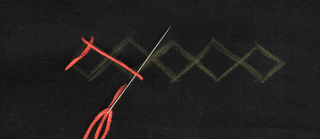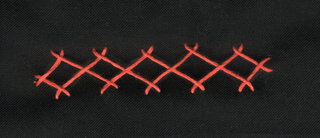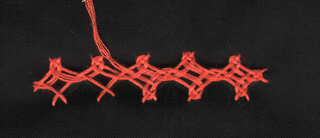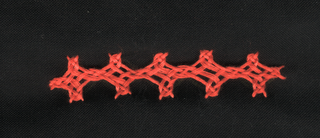The Double Herringbone and interlacing
This motif is merely a build up of the Basic Single diamond.

This motif has as its foundation, the Double Herringbone Stitch - the working of which is illustrated in the picture. Just be sure to follow the same principles of overs and unders we established in the previous lessons.

This illustration shows how to turn once the end of the motif is reached. Notice that the second part of the Double Herringbone is worked from left to right as a continuation of the first part.

The Foundation of Double Herringbone completed.

Now The upper part is interlaced first

When you reach the end, turn and start interlacing the lower half.

The completed motif.
If you have understood these lessons, you can create elaborate designs using these basic motifs. All you need is a graph notebook and some imagination. The possibilities are limitless. Have fun.
I'll come back to you on this topic as and when I come across different motifs.
This motif is merely a build up of the Basic Single diamond.

This motif has as its foundation, the Double Herringbone Stitch - the working of which is illustrated in the picture. Just be sure to follow the same principles of overs and unders we established in the previous lessons.

This illustration shows how to turn once the end of the motif is reached. Notice that the second part of the Double Herringbone is worked from left to right as a continuation of the first part.

The Foundation of Double Herringbone completed.

Now The upper part is interlaced first

When you reach the end, turn and start interlacing the lower half.

The completed motif.
If you have understood these lessons, you can create elaborate designs using these basic motifs. All you need is a graph notebook and some imagination. The possibilities are limitless. Have fun.
I'll come back to you on this topic as and when I come across different motifs.
























